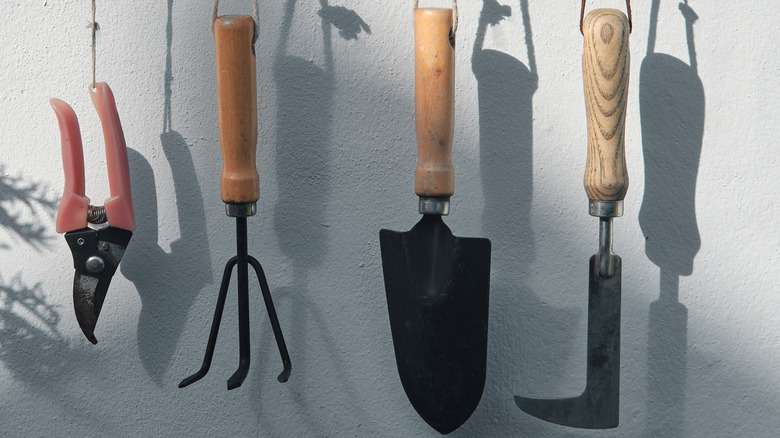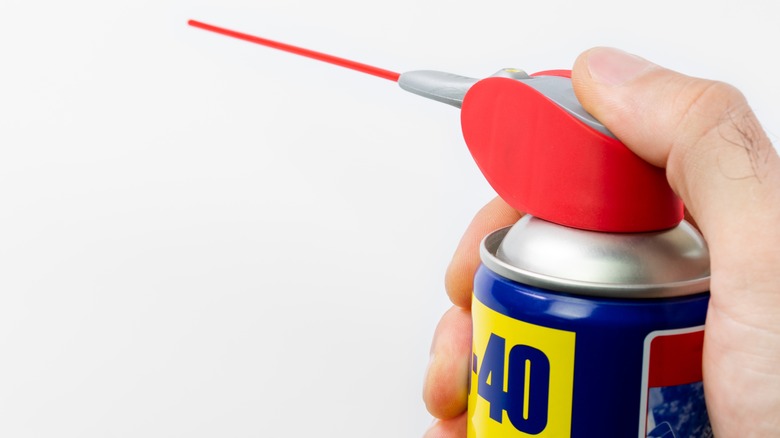How To Keep Your Wooden Tool Handles From Splintering Using This Common Garage Staple
When it comes to yardwork, one of the most frustrating things to deal with is having an important tool's wooden handle splinter and weaken. Of course, tools wearing down over time is to be expected, as items such as shovels and rakes undergo a lot of wear and tear through routine usage. Proper care for these tools is necessary to maximize their longevity and integrity. Fortunately, there's an easy way to keep instruments with wooden handles from cracking under pressure — and all that is needed is a common household product many already own.
The versatility of WD-40 has been repeatedly demonstrated by the numerous hacks related to the canned lubricant that have spread across the internet. It can be used to hide scratches on cars, to clean all manner of electronics, and even to maintain power tools. However, some may be surprised to learn that the substance can also be used to help tools with wooden handles from splintering through a basic process.
How to stop splinters in wooden tool handles with WD-40
In order to lessen the chances of a wooden tool handle splintering, all one needs is a can of WD-40 (or a common WD-40 substitute). Because the lubricant consists of a penetrating oil mixture, applying it to a wooden surface essentially acts as a sealing mechanism. The WD-40 allows the wood to retain a level of moisture that prevents it from drying out through contact with dirt and other substances, which is what often leads to splintering. The application process is as follows:
- Clean the tools with wooden handles in need of protection. If they are grimy, wash them and then dry them.
- If the handles are rough to the touch or heavily weathered, sand them down with a low to medium-grit sandpaper until they are smooth.
- Once the tools are cleaned and ready, spray the entire surface area of their handles with WD-40.
- Let the coated tools rest for anywhere from 10 to 15 minutes while the WD-40 soaks in. After that, use a rag to wipe off any extra oil from the handles.
- The wooden handles of the tools are now sealed in WD-40, preventing them from splintering as easily.
This handle coating process can subsequently be repeated on the same tools for added protection. However, even just doing it once per instrument should be enough to keep them in good shape for the foreseeable future.
When to apply WD-40 to wooden tool handles
While WD-40 can prevent further splintering for wooden tool handles, there isn't necessarily an ideal time in a tool's lifespan to undergo the application process. The WD-40 coating can future-proof brand-new tools, keeping them from splintering at all. Likewise, it can be performed on old and battered instruments that have already begun to splinter, restoring them and preventing them from further damage. Essentially, there's no major downside to applying WD-40 to any tool that has a wooden handle.
In terms of maximizing the benefit of applying WD-40 to wooden tool handles, there is a specific time of year during which it can significantly impact preserving tools against the elements. The cold and dry climate conditions of the winter months mean that wooden items are more at risk of drying out and splitting than usual. Just as how there are things you need to do with your power tools in the winter to keep them safe, coating wood-based tools with WD-40 at this chilly time of year is an important step in helping them weather the cold.
Once the handle coating process is complete, the effects should last for an extended period of time. However, those interested in routinely maintaining the handles should seek to reapply the WD-40 coating roughly once per year to keep everything smooth and protected.


